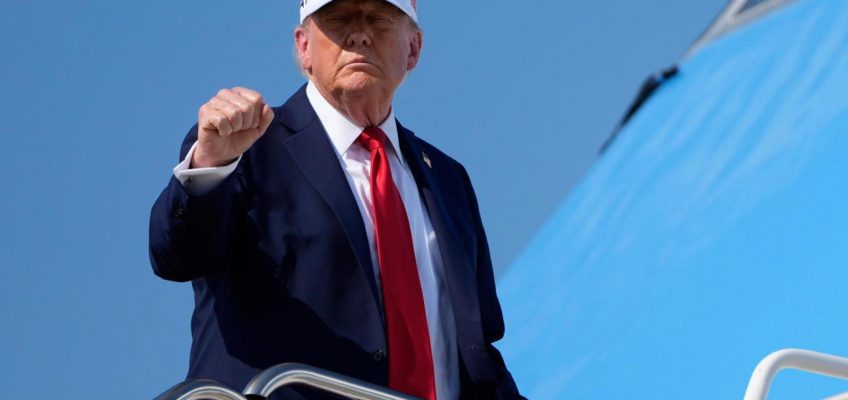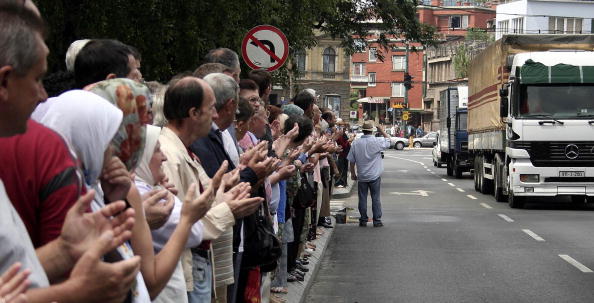By WILL WEISSERT, Associated Press
WASHINGTON (AP) — As President Donald Trump heads to Texas on Friday for a firsthand look at the devastation caused by catastrophic flooding, he has remained conspicuously quiet about his previous promises to do away with the federal agency in charge of disaster relief.
The Trump administration isn’t backing away from its pledges to shutter the Federal Emergency Management Agency and return disaster response to the states. But since the July 4 disaster, which has killed at least 120 people, the president and his top aides have focused on the once-in-a-lifetime nature of what occurred and the human tragedy involved rather than the government-slashing crusade that’s been popular with Trump’s core supporters.
Nancy Epperson, right, and Brooklyn Pucek, 6, visit a memorial for flood victims along the Guadalupe River on Thursday, July 10, 2025, in Kerrville, Texas. (AP Photo/Gerald Herbert)
“Nobody ever saw a thing like this coming,” Trump told NBC News on Thursday, adding, ”This is a once-in-every-200-year deal.” He’s also suggested he’d have been ready to visit Texas within hours but didn’t want to burden authorities still searching for the more than 170 people who are still missing.
Trump’s shift in focus underscores how tragedy can complicate political calculations, even though Trump has made slashing the federal workforce and charging ally-turned-antagonist Elon Musk with dramatically shrinking the size of government centerpieces of his administration’s opening months.
The president is expected to do an aerial tour of some of the hard-hit areas.
The White House also says he’ll visit the state emergency operations center to meet with first responders and relatives of flood victims. Trump will also get a briefing from officials. Republican Gov. Greg Abbott, Sen. John Cornyn and Sen. Ted Cruz are joining the visit, with the GOP senators expected to fly to their state with Trump aboard Air Force One.
It’s relatively common for presidents visiting disaster sites to tour the damage by air, a move that can ease the logistical burdens on authorities on the ground.
Trump’s predecessor, President Joe Biden, observed the aftermath of Hurricane Helene in western North Carolina and Hurricane Milton in Florida last fall by air before meeting with disaster response officials and victims on the ground.
Trump, though, has also used past disaster response efforts to launch political attacks. While still a candidate trying to win back the presidency, Trump made his own visit to North Carolina after Helene last year and accused the Biden administration of blocking disaster aid to victims in Republican-heavy areas.
Kerrville residents Edgar Rojas, second from left, and his wife Perla, alongside daughters Emily, left, and Olivia, visit a memorial for flood victims along the Guadalupe River on Thursday, July 10, 2025, in Kerrville, Texas. (AP Photo/Gerald Herbert)
First lady Melania Trump will accompany the president Friday, marking the second time this term that she has joined her husband to tour a natural disaster site.
During his first weekend back in the White House, Trump again visited North Carolina to scope out Helene damage and toured the aftermath of devastating wildfires in Los Angeles. But he also used those trips to sharply criticize the Biden administration and California officials.
Trump has promised repeatedly — and as recently as last month — to begin “phasing out” FEMA and bring disaster response management “down to the state level.”
During Tuesday’s Cabinet meeting, Trump didn’t mention those plans and instead praised the federal flooding response. Turning to Homeland Security Secretary Kristi Noem, whose department oversees FEMA, he said, “You had people there as fast as anybody’s ever seen.”
Pressed this week on whether the White House will continue to work to shutter FEMA, press secretary Karoline Leavitt wouldn’t say.
“The president wants to ensure American citizens always have what they need during times of need,” Leavitt said. “Whether that assistance comes from states or the federal government, that is a policy discussion that will continue.”
While the focus is on FEMA at the federal level, local officials have come under mounting scrutiny over how much they were prepared and how quickly they acted. But not everyone affected has been quick to point fingers.
Darrin Potter, a Kerr County, Texas, resident for 25 years who saw ankle-high flooding in his home and said he knew people killed, said, “As far as early warnings, I’m sure they can improve on that.”
But he said all the talk about evacuating was missing something important. The area where a wall of water ripped through was a two-lane road, he said.
“If you would have evacuated at 5 in the morning, all of those people would have been washed away on this road,” he said.
During the Cabinet meeting, Noem described traveling to Texas and seeing heartbreaking scenes, including around Camp Mystic, the century-old all-girls Christian summer camp where at least 27 people were killed.
State Department is firing over 1,300 employees under Trump administration plan
The newest way to influence Trump: Nominate him for the Nobel Peace Prize
Head Start will be cut off for immigrants without legal status, Trump administration says
Years later, Trump administration targets key figures in Russia investigation
George Mason University faces investigation in Trump administration’s anti-DEI crackdown
“The parents that were looking for their children and picking up their daughter’s stuffed animals out of the mud and finding their daughter’s shoe that might be laying in the cabin,” she said.
Noem said that “just hugging and comforting people matters a lot” and “this is a time for all of us in this country to remember that we were created to serve each other.”
But the secretary is also co-chairing a FEMA review council charged with submitting suggestions for how to overhaul the agency in coming months.
“We as a federal government don’t manage these disasters. The state does,” Noem told Trump on Tuesday.
She also referenced the administration’s government-reducing efforts, saying: ”We’re cutting through the paperwork of the old FEMA. Streamlining it, much like your vision of how FEMA should operate.”
Associated Press writers Seung Min Kim in Washington and Nadia Lathan in Ingram, Texas, contributed to this report.




